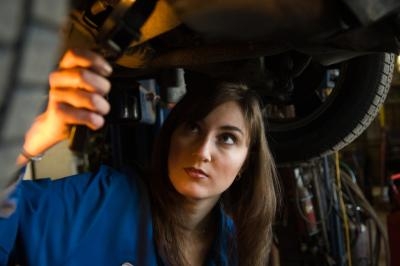
The 1951 Ford pickup model can be identified by its single bar grille with a "toothy" appearance, as well as by its height and width. This pickup is massive in size and houses a powerful V8 beneath the hood, with the front of the truck being even more confrontational with it's large wraparound bumper. This line of Ford pickups ended in 1952, making the 1951 model a special collector's item for enthusiasts.
Purchase handbooks and magazines concentrating on restoring classic Ford trucks, especially those from the 1950s. Find classic Ford enthusiast groups in your area to find others interested in restoring these classic trucks who might assist you with your project. The more knowledge you acquire concerning restoring these classic Ford trucks, the easier it will be to successfully restore one.
Set aside a large work space that can accommodate a fully disassembled Ford truck as well as provide extra space for equipment, storage bins and additional lighting. You also need access to electricity and the ability to keep this space organized to prevent misplacing any parts, accessories or components.
Secure a tarp to the floor in an area of your work space. Place parts and components upon this tarp during your project in order to maintain a clean and organized work space. Create labeled containers for small pieces as well.
Disassemble the exterior by removing the bumpers, the hood, the large front grille, the doors and the tailgate. Remove the headlamps and taillights. Raise your Ford truck with a jack, then secure it with multiple jack stands.
Remove the wheels completely from their assemblies, and use grease and a rubber mallet to help with removing any parts suffering from excessive rust. Remove the axles from the frame by unbolting them. Disconnect the engine and other power components, then use a hoist to pull the engine and transmission out of the truck's body. Place all components onto the tarp, storing smaller pieces within the labeled containers.
Disassemble your Ford truck's interior. Remove the components of the console and then dismantle the interior's trim. Remove the seats and set them aside for individual restoration. Use a Ford-specific reupholstery kit to restore the seats separately. Check the viability of all interior components, restoring those that can be reinstalled. Remove your Ford pickup's front and rear fenders.
Survey all that has been removed from both the exterior and interior of your 1951 Ford pickup. Each viable item needs to be cleaned and restored individually. Replace all damaged parts and accessories, including any metal components with signs of excessive rust or erosion.
Examine the body of your truck, including the frame, hood, bumpers, fenders, doors, floorboards and tailgate for holes, scratches and rust. Perform patchwork on these areas by soldering healthy metal into damaged sections with a MIG welder. Ensure that the body of the truck is straight. Replace any bumpers, fenders, doors or other parts that are severely eroded.
Use a power sander to sand the exterior of your 1951 Ford pickup, ensuring that the surface is smooth and even. Attach the fenders. Make sure that the panels are aligned, then prime the exterior. Once the primer has dried completely, paint the exterior of the truck.
Restore viable power components such as the engine, transmission, radiator, alternator and carburetor. Examine the quality of the driveshaft, starter, axles and brake systems. Replace components as necessary.
Use a hoist to lift the engine's components and then lower them back into your Ford's engine well. Install all of these components, testing to ensure everything is working properly. Installation may take three times longer than disassembly did. Be patient and work slowly to prevent damage.
Ensure the viability of all electrical components, replacing any damaged wiring or segments. Install and rewire the headlamps and taillights, then install the brake systems beneath your Ford truck. Attach the front and rear bumpers, then install the windshield, mirrors and windows. Rechrome damaged trim along the exterior, then attach new wheels. Remove the jack stands and lower the truck safely to the ground.
Install the interior. Start by installing new carpet, then install the reupholstered seats. Install all interior components, including the door panels and handles, console, controls, seat belts and gauges. Ensure that these components are all working properly, then test drive your 1951 Ford truck to complete this restoration process.